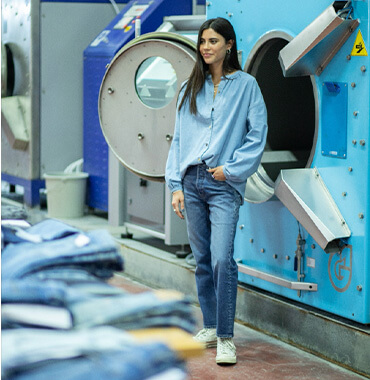New To The Denim Scene: The Kapok Fibre
Silkiness against the skin is a feeling that will never get old. Imagine a vintage silk scarf running through your hands as you tie it around your neck. That buttery softness almost evokes a pleasant sigh of relief. Tencel has helped us offer this smooth hand-feel in denim while reaping all the environmental benefits, but we have also started seeing wider use of the Kapok Fiber in the denim industry known as cotton silk.
Silkiness against the skin is a feeling that will never get old. Imagine a vintage silk scarf running through your hands as you tie it around your neck. That buttery softness almost evokes a pleasant sigh of relief. Tencel has helped us offer this smooth hand-feel in denim while reaping all the environmental benefits, but we have also started seeing wider use of the Kapok Fiber in the denim industry known as cotton silk. So, where does this mysterious fibre come from, how is it processed, and how is it applied in denim? The Kapok fibre is derived from the Kapok tree, a majestic tree home to tropical rainforests worldwide, reaching 150 feet or more. I like to think of the tree as highly intelligent. It sheds its leaves during drought season while its pods/fruit containing the brown seeds and our luxurious silk cotton fibre will burst open while still on the tree and after the leaves have fallen. In Myan myths, the Kapok tree was sacred, and historically, the seeds, leaves, bark and resin have been used to treat dysentery, fever, asthma, and kidney disease. The Mayans also believed that the souls of the dead would climb to the top of the tree, which reached into heaven. Aside from the tree’s ability to heal, it has also been positioned as a more sustainable fibre option. The tree does not require any irrigation or pesticides, as it grows in the wild, and harvesting the kapok fibre does not require chopping the tree down since the magical fibres come from their fruit pods! Once the seed and fibre are removed from the pods, they are stirred in a basket until the seeds fall to the bottom, leaving the fibres behind to dry in the sun. The individual fibres can span from 0.8 to 3.2 cm long with an average length of 1.8cm and a diameter of 20 to 36 micrometres. However, the fibre on its own is too brittle for spinning into yarn and thus, needs a little help through blending to increase its strength. The fibre contains both cellulose and natural plastic-like material called lignin, making kapok a moisture-resistant, quick-drying and buoyant fibre. Not to mention it is also hypoallergenic! We have seen the denim industry experiment with the fibre, but in many places, the trunks of the kapok tree are used to make dugout canoes, seeds processed to extract oil for soap, and the residue used as fertilizer and cattle feed. As for the fibre, it has generally been used in pillows, mattresses and floatation devices. But how is it being used in denim? As Kapok is known for its many naturally occurring benefits and sustainable attributes, we are seeing it blended with cotton to achieve a softer hand feel while keeping an authentic rigid look and diversifying our reliance on cotton. It has also been useful in Spring/Summer collections due to its moisture wicking and quick drying ability! Not to mention, it’s antibacterial properties also help mitigate odor and with denim heads and denim professionals alike that refuse to wash their jeans, this is a key aspect the kapok fibre can help with. Odor be gone! Calik is among the first to experiment with the fibre with Selfsized, Fix Fit, and Denovated concepts for an authentic denim look. The Selfsized concept features an 11oz denim with 100% elasticity to help curb the rate of returns online. Selfsized fabric is exactly how it sounds, as a pair of jeans produced with Selfsized fabric fits a wide range of different sized wearers and overcomes the barriers to shopping online. With the help of the kapok fibre, Selfsized gives you stretch values without polyester! Similarly, Calik’s Fix Fit concept has focused on 40-50% elasticity in an 11 ounce weight that consists of their commercial products, recycled content, and the kapok fibre. Lastly, Denovated gives a salt and pepper look that is perfect for achieving those tasty vintage looks at a weight of 12.5 ounces with recycled content and the beautiful kapok fibre. However, there are a couple of notes of caution. Because the fibre is designed to carry seeds in the wind, it is advised to wear a dust mask when handling kapok as the fibre can fly in all directions and irritate the lungs. It is also highly flammable, which means special precautions should be taken when transporting. On the upside, that means it also makes it great for tinder! But with the desire for more sustainable fibre options growing, there comes the apparent risk of too much demand and insufficient supply. With a healthy balanced array of fibres to choose from, we open up a greater supply for sustainable options and many opportunities for denim. But, let’s remember to consider the entire lifecycle of evaluating sustainable fibres, including growing, harvesting, processing, and end life to ensure we aren’t hopping on the next train to buzzword and greenwashing central!
To view full content and a better mobile experience, try



